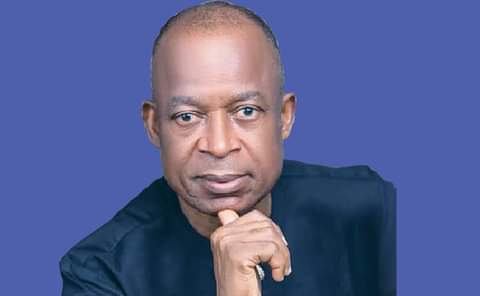More dams needs to be constructed to avert looming flood–Engr. Clem Nze, NIHSA Director-General
The Director-General, Nigeria Hydrological Services Agency, Clement Nze, speaks to TUNDE AJAJA on Nigeria’s vast water resources, the looming flood and how Nigeria can effectively prevent future floods
NIHSA in collaboration with the Nigerian Meteorological Agency and National Emergency Management Agency issued flood warnings that this year’s flood would be worse than that of 2022. So far, how will you assess the preparedness of states and the Federal Capital Territory?
If I may first refer you to what happened last year, in October, 2022 following our periodic updates given to the then President (Muhammadu Buhari) through the minister of water resources, the President inaugurated a committee to look into the issues that concern flooding in Nigeria. A 90-day ultimatum was given to that committee. For more than three months, we met with other relevant agencies, ministries and state governments. We visited some states for assessment, and that exercise set the tone for the preparation for 2023. So, there has been some level of awareness and the zeal by the sub-national governments to participate actively.
What level of collaboration exists between NIHSA, NEMA and NiMET as regards minimising the impact this year?
The three agencies have been working together. For instance, NiMET issued the forecast in January, including the volume of rainfall to expect in every local government. Less than a month after, NIHSA also released information about the level of flood to expect and locations that might be affected. Then, NEMA, which oversees disaster management, took it up from there. I think they have organised about three levels of stakeholders meeting with regard to the forecast. They invited state governments, state emergency management agencies and some international agencies. We have also met about two times to come up with documents with regard to what should be done. The FCT has organised about two stakeholders workshops, and one was about two weeks ago and they brought in all the stakeholders within the FCT, including the local divers, town criers, responders, fire service, police and the Nigeria Security and Civil Defence Corps to review their strategy for 2023 so that they would be able to do better than last year. Nobody died as a result of the flood in the FCT last year, but this time round, they want to ensure that properties are not lost. So, there has been some level of awareness and they have keyed into what has been said by all the agencies. Let me add that the governor of Akwa Ibom State (Umo Eno) invited the three agencies with their teams to the state. That would be followed by Ekiti State and other states would be visited. So, the state governments are getting more prepared than what we used to see.
Some people have found the predictions scary, how worried should Nigerians be about the flood that is to come in the remaining part of the year?
I would always say it is better to err on the side of caution. There is a continual build-up of rain, starting from the southern part of Nigeria with attendant flood that may be associated with it. From what we have projected, it seems to me that the rain is following the prediction. As we move towards July, that is when the rain would begin to gather more heat, and the flood would likely intensify in July, August and September. In fact, last year, the disaster continued to occur even in October. So, we should be prepared to experience more floods this year. From what we are seeing, it calls for more caution and action on the part of the sub-nationals to ensure that the disaster aspect of flood is minimised. A lot was lost last year, from human beings to the economy and infrastructure.
The 2022 floods claimed over 660 lives, while thousands of houses and hectares of farmland were washed away. Should the severity be blamed on poor preparation or it was inevitable?
I will blame it on poor preparation. Forewarned is forearmed. Let me use Abuja as an example. This year alone, hundreds of houses have been demolished because they are getting prepared; they are working in both the villages and in the city. Many states were caught napping last year; they didn’t do what they were supposed to do. We should abhor this style of living based on wishful thinking; that it may or may not occur. Once people have been warned, let the states take necessary action, including removal of obstruction from the flood plain. You find that the floods keep occurring in the same locations year in, year out. So, states should be prepared and take necessary action. As human beings, we go for medical check-ups, maybe once in a year at the very least. Likewise, states are supposed to take an inventory of their environment after each flood incident. There are flood marks, and in such areas, we are supposed to remove the structures and clear the drainages, but not much was done. When we were having those presidential committee meetings, we were in groups. The senators, governors and permanent secretaries were in the steering committee and we said so much in those meetings, but only two states had physical representatives; Anambra State deputy governor and commissioners from Jigawa State. So, some states were not prepared and didn’t do what they should do to prevent flooding.
Like you mentioned earlier, some states are getting prepared, but in many instances, people who live in flood prone areas refuse to leave despite several warnings, what do you think can be done in such cases?
It is a very big challenge. I think the states should devise relevant adaptable strategies to handle this. Apart from persuading or encouraging them, you can also do certain things for them. Yes, we know it’s for their sake, but during Covid-19 and Ebola, governments at different levels distributed food items so people could eat, so it will not be out of place if you ask people to leave and you give them some things, like incentives. Entice them by whatever means you can so they could leave, because you can’t just leave them there. Force may not work in all cases. Sometime in 2014, the Niger State Government adopted what they called wet housing and dry housing. They built some structures uplands, so that during the rainy season, they would relocate people within the banks of River Niger such that they could still visit their businesses, fish ponds, farms and return to the alternative settlement afterwards. That lasted for about three months. To relocate to another settlement is not easy. Ibaji Local Government Area in Kogi State is a major flood prone area, I was there in 2018 and everywhere was heavily flooded. They said in 2012, most of them ran away from their homes and many things were destroyed. In 2018, some of them stayed on trees to escape the flood. So, governments should help their citizens; give them palliatives and encourage them to leave. In Africa, Nigeria in particular, we look out for ourselves, so people around flood plains can go and stay with their brothers or sisters till the flood is over. Let’s accommodate our kith and kin to survive this season.
Unregulated developments, especially building construction on flood plain, seem to have contributed immensely to the flood problem, to what extent can the poor implementation of planning laws be blamed for the perennial flooding?
That is one of the areas that has been badly bastardised, and it’s contributing to flooding in both cities and villages. Take the FCT as an example, urbanisation, population increase and rural-urban migration put a lot of pressure on housing, causing deficits. We have been calling on estate developers that before you embark on the development of any estate, you should do the Environmental Impact Assessment. If you are bringing a strange object into a virgin land, you should be able to find out what would be the implication on the environment. Also, there should be flood vulnerability mapping, but we see that many estate developers get hectares of land for development, they sit in their office and use pencil and ruler to demarcate plots of land and innocent persons would go and buy such properties. After that, they use interlocking stones for the roads, which reduces water penetration to the ground, and that makes it worse, whereas, they should have created the path for flood.
Could you tell us more about the flood vulnerability mapping?
The mapping would show the location within that area where you should channel run-off. These days, many town planning authorities are not working; they only exist in their offices. Some occasionally mark ‘Stop Work’ on some buildings, but by and large, so many cities and estates are being developed without making provision for flood. NIHSA has mapped some zones over the years. In 2021 or 2022, we completed the mapping of the South-West in addition to Edo State. We wanted to present the document to these states and we wrote to the governors, commissioners for environment and water resources and their permanent secretaries, inviting them to see the document that detailed the flood issues within their domain. We had done it in the South-South and North-Central. It was quite appalling when we came that day, at Ikeja, and it was only one permanent secretary that came from the seven states. In fact, I called one of them, who said he had a political event to attend, and he didn’t come. Apart from the general invitation, I sent messages to some of them, but they didn’t come. We have to take things more seriously for our sake.
One of the manifestations of climate change is extreme weather, both heat and rainfall, is this recurring flooding due to climate change entirely or are there other human activities fuelling it?
Climate change is a reality and it is contributing a lot to what is happening today. There are some locations that hitherto experienced less rainfall but are experiencing heavy rainfall today, because of climate change. This is however aggravated by human activities, like deforestation and high urbanisation. When people build houses these days, everywhere else is covered with interlocking stones, which does not allow percolation like asphalt, even though it’s more beautiful. Before, about 40 per cent of the land was used for building while the rest would be grass or used to plant trees. But today, when we build, it’s almost like beacon to beacon, with interlocking stones covering any space left. Climate change is a reality that is constituting a lot of problems with regards to flooding. For example, a place like Maiduguri where the total amount of rainfall may not be more than 400 to 450 millimeters in a year, about three months of rainfall, but last year, within 24 hours, they had about 209mm of rainfall, in one day. It wasn’t like that in the past. So, where will the water go? It will translate to flooding. Also, in a particular community in Jigawa State, an elderly man said they had been living there for 53 years and they never experienced flooding or rainfall for about three days, until last year. This is climate change and it is real.
During the flooding in 2022, there were suggestions that Nigeria needs more dams, what do you make of that?
I have always said that Nigeria is grossly under-dammed; we don’t have enough dams, especially when compared to the amount of surface water we have in Nigeria and our land mass relative to other countries we can compare Nigeria with. Approximately, Nigeria has about 408 dams, and according to the standards by the International Commission on Large Dams, a large dam is 15 metres high and above. Nigeria has only about 52 large dams, out of its 408 dams. Canada has 15,000 dams in all, out of which about 933 are large dams. India has about 25,000 large dams, the United States has 5,000 large dams. Some smaller countries in Africa even have more dams than we do. We need more dams in Nigeria. Dams serve several purposes, like hydropower, irrigation and flood control. So, we need more. It will go a long way to control flood incidents in the country.
Instead of the 408 dams, what is the minimum number of dams Nigeria needs, given her size and volume of surface water?
I can’t be specific on that, but at the Federal Ministry of Water Resources, they have a blueprint on that, so that investors who are interested in building dams for irrigation or hydropower could do so, and that was why it was liberalised. In a country like India, a community could build a dam for hydropower to serve that community. It doesn’t have to be a giant dam, such that if it collapses, it will submerge the entire community. Even if we build 1,000 dams, we still need more.
Why does Nigeria have that small number of dams, despite the money the country has generated over the years?
I think it’s about priority. The states can afford to build small dams in their domain. If you go outside Nigeria, some farmers can come together and build one to serve them. A dam is simply an obstruction or an elevated structure you build across a river for storage of water. It helps to regulate the amount of water wasted. So, every dam doesn’t have to be as big as Kainji Dam. You can have smaller dams for different purposes.
Nigeria has a lot of idle dams, like the Oyan Dam in Abeokuta, Ogun State, what is the implication of leaving dams idle?
If dams are not properly managed, they pose some problems to communities around. Most dams, including those in Nigeria, have been silted up. For some of them, over 30 per cent of their capacity is silted up (filled with sand or mud). When you build a dam that should store 100 million cubic metres of water, you can make an allowance for about five per cent that might be occupied by sand. But over the years, most of these dams have been silted up, to the point that their carrying capacities have been reduced. Given the cost of dredging or desilting the dam, any little rain leads to flooding, because the capacity of the dam to absorb more water has reduced, and there is a level water must not exceed so the dam doesn’t collapse. You can do proper reservoir operation to know when to release water and when to close your gate to store the water. About a month ago or more, the authorities of Ogun-Oshun River Basin Development Authority released the sequence of how water will be released from the Oyan Dam, and that tells people the volume of water to be released within a specified time. They held stakeholders’ meetings with Lagos and Ogun states to notify them of these details, but most of the time, people are not prepared to do what they should. Some people would even say ‘why not open your gate to reduce the water you have so that by the rainy season, you close it to contain all the water that would come, to avoid flooding. Take Kainji Dam, a hydropower dam, as an example. If you lower the gates to release water and there is not enough rain for you to have sufficient water to power the turbines that would generate power, what happens? So, by and large, dams can help to address flooding, but the release of water is done skillfully.
The United Nations Children’s Education Fund said in March that 133 million Nigerians lacked access to potable water, but with the volume of surface and underground water in Nigeria, isn’t that enough to meet its domestic and irrigation needs?
A World Bank report says close to 80 per cent of the world population depends on ground water for their domestic water needs. As children, some of us saw pipe borne water in cities. I don’t know what happened that you can no longer open the tap and get water. The tragedy of it is that many states have abdicated their role of providing water for the people, whereas the boreholes many people resort to have their implications for the environment. The lack of potable water is a product of negligence by the sub-nationals. Let me give you an example, the Federal Ministry of Water Resources built a dam in one of the states for billions of naira. I won’t mention the state. What was left was for the state to treat the water and supply it to the people, but the state government said it could not afford N3m every month for the treatment of the water. All over Nigeria, especially in the northern part, we have a lot of dams but many of them are lying idle. What stops state governments from building treatment plants to make the water safe for domestic use. We can’t build a country on boreholes, especially when we have water that can be treated and channeled for use. You go to some estates and almost every house has a borehole, but that drilling is not good for the environment. Last year, the then Minister of Water Resources gave us the task as an agency that we should be able to say the amount of ground water available in a particular location every two to three years. So, we have enough to take care of what we need if properly managed. In countries like Israel, they know how much water every farm needs and they supply them, without giving them more than they need. But here in Nigeria, we waste water. You see a carwash by the road and you would be amazed by the volume of water being wasted. The fresh water that we lose annually is over 200 billion cubic metres.
What is the situation in other countries?
I was in Kenya in March and they showed me a community where it had not rained for about a year. Animals died and some people died too. But here in Nigeria, we have it in abundance. We have been urging states why do you allow this precious gold, which we call flood, to pass through your territory and just flow into the Atlantic Ocean, and after about two to three months, your people cry out that there is no water to do agriculture. So, why not build a detention basin that will be properly constructed. Take the Jabi Lake in Abuja for example, there is water there year round, and because of that availability, the serenity is there, trees are there, even birds come there for habitation. People go there for sports and picnics and a mall has an ocean view property in the area. The groundwater there up to Gwarinpa life camp and Utako has been highly replenished. So, states can create small communities like that. Once you have a well constructed detention basin where excess flood will be diverted to, people can go there and make a livelihood year round.
One of the recommendations in the 2023 climate-related disaster preparedness and mitigation strategies document jointly prepared by NIHSA, NiMET and NEMA was that Nigeria should tighten its diplomatic relations with neighbouring countries like Cameroon over the release of water from their dams, is that step being taken?
The diplomatic option is not that straightforward, because it’s national interest first for every country. We have been having some issues with Cameroon as regards water management. We have visited the country a number of times to seal agreements on the sub-basin. The President of Cameroon, His Excellency, Paul Biya, was in Abuja in 2016 to see former President Muhammadu Buhari and they signed a Memorandum of Understanding with regard to the management of the resources of the sub-basin, especially River Benue, and other structures, like Lake Nyos in Cameroon, which is a natural lake, so that Nigeria will not suffer adversely in case something happens. In August, 1986, the Lake Nyos exploded and threw up poisonous liquid into Nigeria through Adamawa State and it entered the Katsina Ala River (Benue State) and so many animals died. The challenge is that the francophone countries.
(Sunday Punch)





